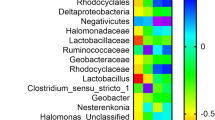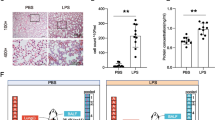Abstract
Objectives
To investigate the mechanism of the Chinese medicine theory that Fei (Lung) and Dachang (Large Intestine) are exteriorly and interiorly related via synchronous observation on the dynamic changes of the respiratory and intestinal microflora.
Methods
Forty specific pathogen free Sprague-Dawley rats were selected and randomly divided into blank (10 rats) and chronic bronchitis model groups (30 rats). The blank group rats were put into the smoke-free environment and the model group rats were put into the smoke environment in order to establish pulmonary disease (chronic bronchitis) model. Then the corresponding changes of the respiratory and intestinal microflflora of the model on 20th, 50th and 70th days were synchronously observed.
Results
The respiratory tract microflflora showed an increase in the total aerobic and Staphylococcus aureus and reduced anaerobic amount signifificantly on 20th day in the respiratory tract microflflora (P<0.05 or 0.01). On 50th day, total aerobic, total anaerobic amount and bififidobacterium signifificantly increased (P<0.05). On 70th day, Staphylococcus aureus reduced and lactobacillus increased signifificantly (P<0.01). The intestinal microflflora showed an increase in the total aerobic, Clostridium perfringens, enterobacter and enterococcus significantly increased on 20th day (P<0.05 or 0.01). Staphylococcus aureus on 50th day increased significantly (P<0.05). Total aerobic and enterococcus increased, total anaerobic and Clostridium perfringens reduced signifificantly on 70th day (P<0.05 or 0.01).
Conclusion
The microecosystem of respiratory tract and intestine of rat model during the pathological process showed a dynamic disorder, indicating an interaction between the lung and large intestine which may be one of the connotations as they exteriorly and interiorly related.
Similar content being viewed by others
References
Meng QY, Zhang QX, Gao SH. Investigating on theory of lung and large intestine being interior-exteriorly related based on theory of fluid being related to humor. J Beijing Univ Tradit Chin Med (Chin) 2013;11: 729–731.
Mo FF, Ma SL, Li HT, Zhao DD, Wang LQ, Ni JX, et al. Discussion on the origin and connotation of the “lung and large intestine being interior exteriorly related” based on TCM classics. Global Tradit Chin Med (Chin) 2015;2: 165–168.
Mo FF, Li HT, Wang LQ, Gao SH. Modern research progress of the lung and the large intestine being interiorexteriorly related theory in TCM. Chin Arch Tradit Chin Med (Chin) 2012;3: 512–514.
Zheng XR, Yang Y, Zheng XL, Zhou XY, Ding WJ, Liu WH. Research on the relativity of lung and large intestine from the perspective of micro-ecological changes of the lung and large intestine. J Tradit Chin Med (Chin) 2011;52: 865–867.
Hui Y. Study on change rules and pathological mechanism of “pulmonary disease affected large intestine” based on pulmonary disease animal model pathological morphology and related controlling matters changes [dissertation]. Chengdu: Chengdu University of Chinese Medicine; 2012:41-51
Tang YJ, Yang Y, Hui Y, Chen XB, Tang HQ, Wang BJ, et al. Exploration on animal model replication of lung disease involving intestines. Chin Arch Tradit Chin Med (Chin) 2012;30: 1732–1734.
China National Health Inspection. Technical standards for testing and assessment of health food (2003 Edition). 2003:148-153.
Cao SY, Chen AC, Wang MS. The research progress about of the influence of microorganism infection on the respiratory tract bacteria flora. Heilongjiang Animal Sci Veter Med (Chin) 2008;9: 19–20.
Wang JH. Traditional Chinese medicine and the positive correlation with homeostatic evolution of human being: Based on medical perspective. Chin J Integr Med 2012;18: 629–634.
Li LJ, ed. Infectious microecology. 2nd ed. Beijing: People’s Medical Publishing House; 2012:11–84.
Author information
Authors and Affiliations
Corresponding author
Additional information
Supported by the National Basic Research Program of China (973 Program, No. 2009CB522706)
Rights and permissions
About this article
Cite this article
Zheng, Xl., Yang, Y., Wang, Bj. et al. Synchronous dynamic research on respiratory and intestinal microflora of chronic bronchitis rat model. Chin. J. Integr. Med. 23, 196–200 (2017). https://doi.org/10.1007/s11655-016-2731-7
Received:
Published:
Issue Date:
DOI: https://doi.org/10.1007/s11655-016-2731-7




